Introduction
Scientific field studies of natural gas hydrates have been carried out in Canada for many years by the Geological Survey of Canada and by a number of universities. This article describes the two largest programs: (1) Arctic permafrost-related hydrate studies, including the Mallik research drilling on the Mackenzie Delta and, (2) Geophysical studies and ODP drilling (international Ocean Drilling Program) of marine gas hydrate beneath the continental slope off Canada’s west coast. Gas hydrate has been known for many years as a problem in blocking cold-region natural gas pipelines, and as a drilling hazard in the Arctic. Shallow gas in the Mackenzie Delta, that may be attributable to hydrate, resulted in the loss of life of two drillers during early exploration. However, natural gas hydrate studies have rapidly expanded globally in recent years, with large programs in Japan and USA, and considerable efforts in Canada, India, Korea, and numerous other countries.
Why the sudden interest? There are three reasons, (1) Gas from hydrate may be a new clean energy source. It is now recognized that there are huge amounts of natural gas, mainly methane, tied up in gas hydrate globally, (2) Natural gas hydrate may play a role in climate change. Methane is a strong greenhouse gas so its escape to the atmosphere from natural gas hydrate could result in global warming, (3) Gas hydrate is a hazard in conventional hydrocarbon exploration, from shallow gas release and from seafloor instability, especially in the arctic and in deep water where hydrate is stable.

By most estimates, gas hydrate is the largest global reservoir of organic carbon, greater than all conventional hydrocarbons (Figure 1, after Kvenvolden, 1993). The greatest interest in energy from hydrate comes from countries that have limited domestic reserves of conventional hydrocarbons such as Japan, USA, Korea, and India. Even high-cost domestic energy is attractive to these countries if there is a security of supply. There is now little doubt that the quantity of gas in hydrate is large. The question for economic development is, can a commercially viable recovery system be developed?
Methane is some 30 times more effective as a greenhouse gas than CO2, although it oxidizes quite quickly in the atmosphere. In one model, natural hydrate dissociation due to human-initiated global warming feeds back to further warming and run-away global temperature increase. Present atmospheric methane is increasing at such a rate that if it continues, methane will be the dominant greenhouse gas in the second half of the century. Destabilizing of natural gas hydrate may be contributing to this buildup. It has been argued that at least one hydrate-mediated catastrophic warming is evident in the past geological record. The paleo-record of a late Paleocene thermal maximum has been attributed to dissociation of global gas hydrate that contributed a huge blast of carbon to the Earth’s atmosphere (e.g., Dickens et al., 1997). A catastrophic temperature increase resulted, giving a 5-7°C rise in deep ocean temperature. Also, natural hydrate dissociation could be associated with the end of glacial periods. These arguments are persuasive, but only circumstantial. We do not know how such a methane release can occur, nor whether the methane comes mainly from the arctic land and shallow sea hydrate which is most susceptible to atmospheric temperature change, or from the larger deep sea hydrate at lower latitudes which probably is less accessible to atmospheric temperature change.
What is gas hydrate? Where does it occur? How does it form?
Gas hydrate is a clathrate structure having gas enclosed in water molecule cages. Hydrate is similar in appearance to water ice and to dry ice (CO2) (Figure 2), and many but not all of its physical properties are similar to ice. Most natural hydrate contains biogenic methane formed by biological breakdown of sediment organic material at low temperature. However, there are occurrences of thermal gas containing higher hydrocarbons, especially in regions of conventional hydrocarbon concentrations. Although the volumes are huge, natural hydrate is a relatively low density energy source. Pure methane hydrate produces 164 volumes of gas at STP. Extensive natural gas hydrate is found in two regions, on land and shallow seas in arctic permafrost areas and beneath some continental slopes at all latitudes. Arctic hydrates probably represent a much smaller total gas reservoir than the marine occurrences, but the former can have very high concentrations and are more accessible. Therefore, they may be the first exploited, and they probably are the most sensitive to climate change.

The most common occurrences of natural methane hydrate partially fill sediment pore spaces, although massive hydrate has been found as nodules and occasionally as thick veins or lenses. Hydrate is frequently concentrated in sandier high porosity-permeability sediment sections, especially in arctic occurrences. Most deep seafloor hydrate occurs in unconsolidated or semiconsolidated sediments, commonly silts, with about 50% porosity but quite low permeability.
The dissociation or melting temperature of hydrate is strongly affected by pressure, in contrast to water ice that has only a small pressure coefficient. Methane hydrate is stable at the conditions of the deep seafloor and beneath land in the arctic where average surface temperatures are very low (Figures 3 and 4). The base of hydrate stability is commonly a few hundred metres below the seafloor on continental slopes, and up to 1000 metres below arctic permafrost areas. Hydrate is not stable beneath continental shelves at temperate latitudes; the minimum water depth there is 600-800 metres.
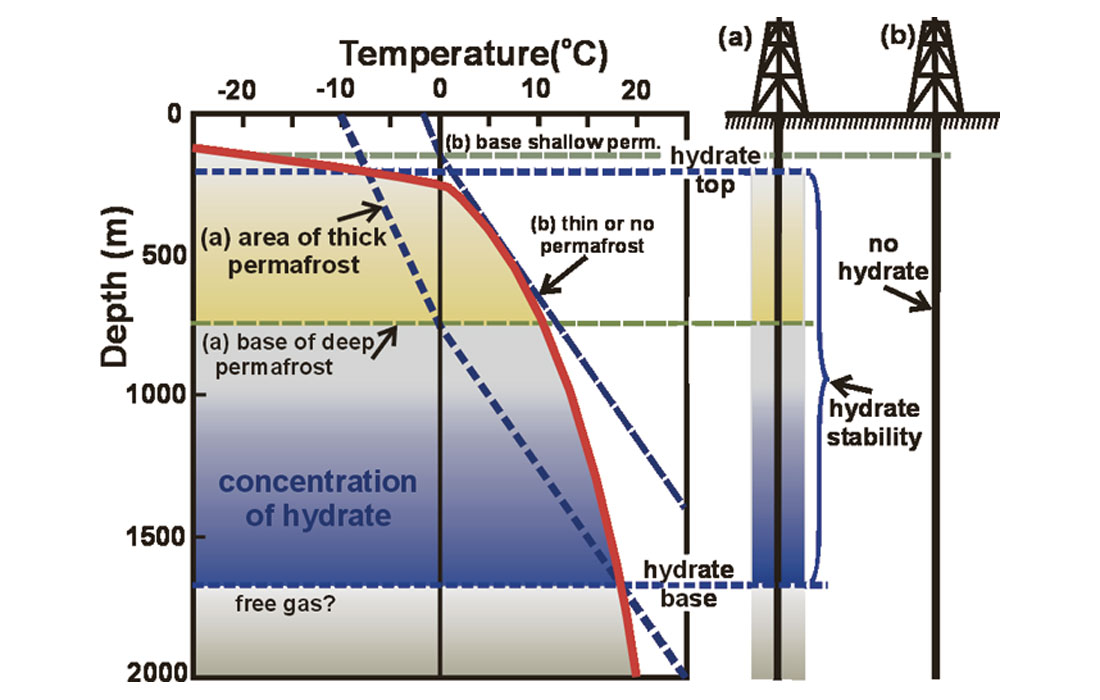
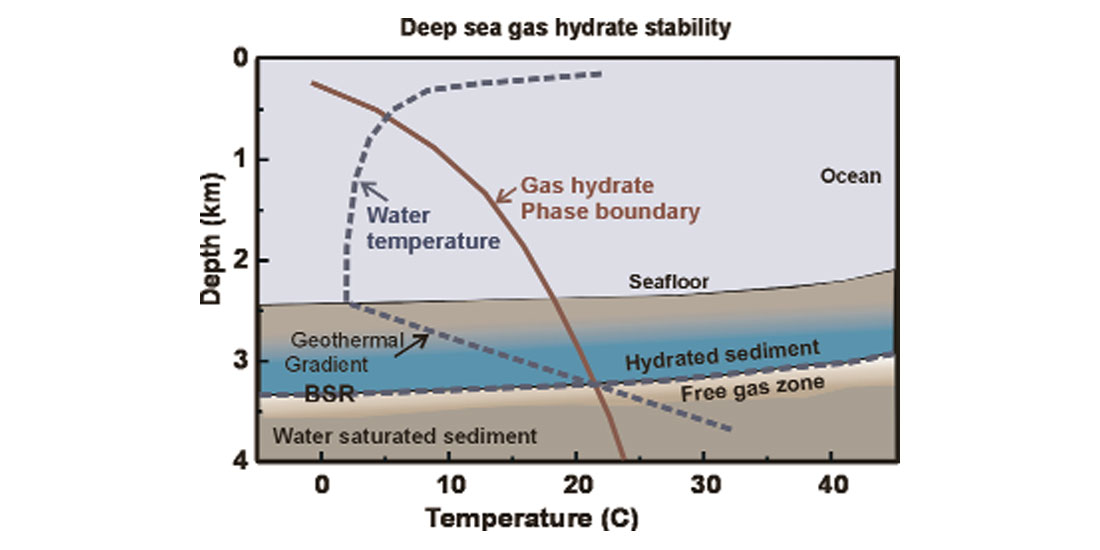
Usually the amount of local sediment organic carbon is not sufficient to produce substantial concentrations of methane hydrate. Biogenic methane generated over a large depth interval must be concentrated upward to the hydrate stability field. Migration is either as free gas or as fluid containing near-saturation concentrations of dissolved methane. Especially in arctic land occurrences, this upward migration may be similar to conventional hydrocarbon migration with hydrate concentration in similar structures, although restricted to shallow depths. The important difference is that the hydrate itself may form the trap against further upward migration and loss. This is similar to the seal provided by permafrost. It is interesting that gas is observed escaping to the surface through some arctic lakes that, because of their warm temperature, provide underlying holes in otherwise continuous permafrost. In contrast, for many marine occurrences there is less structural control. Widespread pervasive upward migration and horizontally semi-continuous hydrate formation is inferred.
The most common environment for seafloor hydrate is in clastic subduction accretionary prisms (i.e., active margin fold and thrust belts), such as off western Canada and SW Japan, where tectonic sediment accretion and consolidation results in upward fluid migration and expulsion. The few places where widespread hydrate occurs beneath stable continental margins, upward fluid migration is also indicated. The well-studied Blake-Bahamas area off eastern U.S. is an example, although the concentrations there are fairly low. Hydrate is not usually found beneath the deep sea floor of ocean basins, only beneath continental slopes, presumably because in basins there is little upward fluid expulsion to concentrate methane upward into the stability field.
An interesting recent occurrence highlights that large amounts of natural gas hydrate really exist; indications of their existence cannot just be artifacts of seismic or other remote sensing methods. A fishing dragger dredged and loaded on the deck several tons of gas hydrate from the seafloor of the upper continental slope off the west coast of Vancouver Island. No doubt disappointed about the lack of fish, the wise crew shovelled the hydrate over the side as quickly as possible before anyone lit a match to smoke! Apparently there was great frothing in the ocean as the hydrate dissociated to methane in the warm surface ocean water.
How do we detect gas hydrate?
The change in sediment physical properties due to the presence of hydrate and of underlying free gas allows detection and semi-quantitative concentration estimates in field studies, and in exploration and research wells. The two primary properties are seismic velocity and electrical resistivity. Both properties can be measured in field surveys and in downhole logs. Sediment velocities are strongly increased by the inclusion of high-velocity hydrate. As is well known, even a very small concentration of gas can decrease velocity substantially. Partial replacement of pore fluid by hydrate does not change the density much, so the impedance contrasts that produce hydrate-related reflections are primarily due to velocity. Because the formation of hydrate excludes salinity, inclusion of hydrate increases sediment electrical resistivity. Small amounts of gas have only a small effect on resistivity.
For marine occurrences, the bottom-simulating reflector (BSR) is the most obvious indicator of gas hydrate. The BSR occurs at the base of the P-T stability field for hydrate. It marks the bottom of the hydrate “ice”, and the top of underlying free gas. Since isotherms approximately parallel the seafloor, the base of stability also commonly parallels the seafloor. BSRs can be impressive reflectors that cut completely across dipping stratigraphic reflectors. Understandably, until they were understood, BSRs often were though to be artifacts of seismic acquisition or processing.
BSRs are produced by the negative impedance contrast between high velocity sediments containing hydrate and low velocity sediments containing free gas (Figures 5 and 6). An example of a strong BSR on the continental slope off Vancouver Island is shown. For those accustomed to interpreting subtle seismic characteristics, this reflector can be refreshingly simple and unambiguous. It is important to recognize that BSRs require an abrupt impedance contrast. Hydrate can be present where there is no BSR and a BSR can occur where there is little hydrate and only small amounts of underlying free gas; small amounts of gas can have a large velocity effect.

Figure 5. Example of a strong BSR near ODP Site 889 off Vancouver Island showing the simple negative reflection waveform, opposite to that of the seafloor.
Figure 6. Simple synthetic seismogram that reproduces the main features of the BSRs. The seafloor reflection results mainly from the density contrast and the BSR mainly from the velocity contrast.
For Arctic permafrost areas, hydrate has been detected mainly in conventional exploration well data, especially by high velocities in borehole sonic logs, high resistivities in electrical logs, and high mud gas. A BSR is rarely generated in these areas. The impedance contrasts from hydrate and underlying gas either are not sufficiently large or are not sufficiently abrupt. A critical requirement for quantitative estimates of hydrate and underlying free gas is accurate knowledge of the reference velocity and resistivity depth profiles for no-hydrate and no-gas. References are especially difficult to obtain in the arctic where there is overlying high-velocity, high-resistivity permafrost.
Two Canadian Study Areas
Gas hydrate in Canada as been studied off all coasts and in the arctic associated with permafrost. Hydrate is not common on the east coast continental slope, at least as evident by BSRs. However, as exploration and development move to deep water where hydrate is stable off Newfoundland and Nova Scotia, the hazard from hydrate and underlying free gas may become important. In this article we present results from the two areas where there has been most extensive study and research drilling, the Mackenzie Delta and the continental slope off Vancouver Island.
The Arctic
The Geological Survey of Canada and several universities have carried out studies of gas hydrate in the arctic for many years with application both to hazard in conventional exploration and for its role in climate change. Assessments of gas hydrate occurrence in the Mackenzie Delta-Beaufort Sea region have been made mainly on the basis of data obtained from hydrocarbon exploration wells. Indirect evidence includes well log responses, steady buildup of shut-in pressure during production tests, and gas flows during drilling. A database by Smith and Judge (1995) showed 17% of 145 onshore wells in the Mackenzie Delta area having evidence of gas hydrate. All of the occurrences are in the clastic sedimentary rocks of the Kugmallit, Mackenzie Bay, and Iperk sequences. Two were associated with ice-bearing permafrost; the remainder were beneath the permafrost interval. The frequency of gas hydrate evidence in offshore wells was greater, 63% of 55 wells. Smith and Judge (1995) have estimated that the Mackenzie Delta-Beaufort Sea region may contain 16 trillion m3 of natural gas in hydrate form.
The Mallik 2L-38 Gas Hydrate Research Well
This earlier arctic hydrate work led to a much larger effort in drilling on the Mackenzie Delta of the first arctic research well specifically for gas hydrate research (Figure 7). The well was an effort by a consortium including the Japan National Oil Corporation (JNOC), the Geological Survey of Canada, and principal collaborators, the Japan Petroleum Exploration Company (JAPEX) and the U.S. Geological Survey. The research well (JAPEX/JNOC/GSC Mallik 2L-38) was drilled to a depth of 1150 m on the north coast of the Mackenzie Delta near the site of an existing industry exploration well. Many of the results have been published in a series of article in GSC Bulletin 544 (Dallimore et al., 1999). Scientific operations included permafrost and gas-hydrate bearing core samples, downhole geophysical logging, and inhole vertical and offset seismic profile surveys (VSP). Laboratory studies and modelling included sedimentology, biostratigraphy, physical/petrophysical properties, pore-water and gas geochemistry, geophysics, and reservoir characteristics of the Mallik field gas hydrate accumulation. Only older seismic data and a test high-resolution survey are so far available over the site (e.g., Figure 8). The well delineated the most concentrated gas hydrate deposit presently identified, and recovered significant amounts of hydrate. The Mallik hydrate layers exceed 110 m in thickness, in some parts having 80% pore saturation by hydrate (Figure 9). The total amount of insitu gas within the Mallik structure is estimated to be approximately 100 billion m3 (see Dallimore et al., 1999).

A second research well is now proposed close to the previous site. A production research well and two nearby science observations wells are planned for the spring of 2002 by an expanded international consortium of Japan, U.S.A., Germany and Canada, to carry out more extensive engineering tests on the production and geotechnical properties of gas hydrates and the stability of the gas hydrate to climate change.
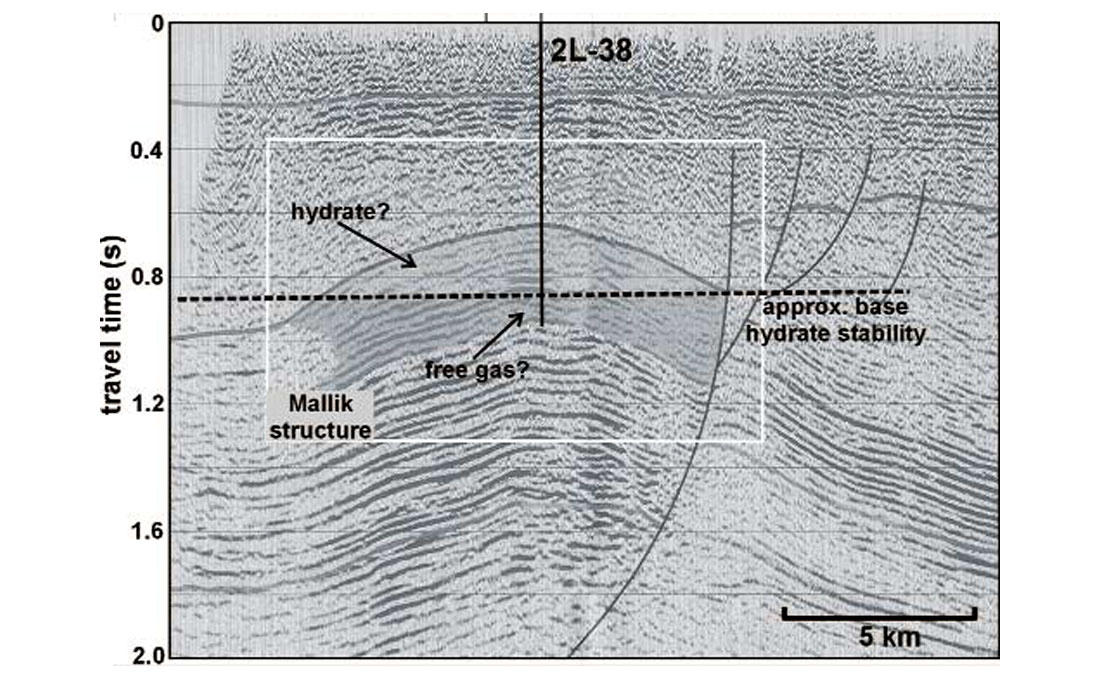
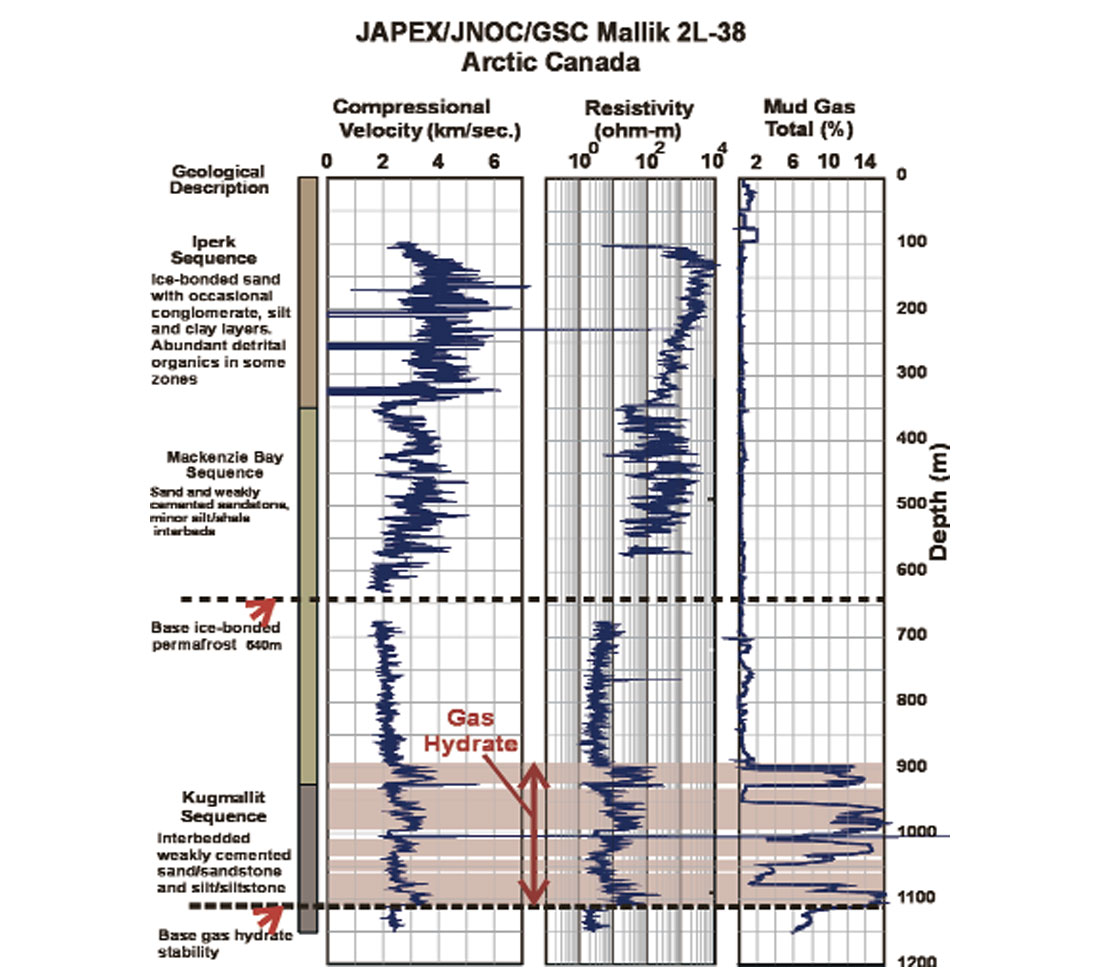
Offshore western Canada
Marine gas hydrate was first discovered beneath the continental slope off the west coast in conventional marine multichannel seismic data acquired as part of the Geological Survey of Canada’s Frontier Geoscience Program. This program involved surveys of the resources in the 200 mile zone off Canada’s west coast following the Law of the Sea convention. Several additional multichannel survey were acquired as part of a site survey for drilling by the international Ocean Drilling Program (ODP). A successful proposal to ODP resulted in two closely spaced, shallow research wells into the mid continental slope off Vancouver Island (ODP Sites 889 and 890) and a reference well in the adjacent deep sea Cascadia Basin (ODP Site 888) (ODP Leg 146; Westbrook et al., 1994). There is now a very comprehensive geophysical data base from surveys, studies and sampling in the area with work by the Geological Survey of Canada, University of Victoria, University of Toronto, Dalhousie University, Cambridge University U.K., University of Bremen Germany, Scripps Inst. of Oceanography California, the U.S. Navy Research Laboratory, and numerous others though the Ocean Drilling Program. The work includes numerous seismic reflection surveys with a wide variety of systems, electrical profiling, thermal studies, seafloor core sampling, and remotely operated submersible (ROV) studies (Figure 10) (e.g., Hyndman et al., 2001). Most information has come from the seismic surveys, including mapping the area of the BSR (Figure 11), determining the depth distribution of hydrate and underlying free gas, and the geological controls of hydrate formation.

On this margin there is a large clastic accretionary sedimentary prism (i.e., active fold and thrust belt), the most common environment for high concentrations of marine gas hydrates. BSRs are evident beneath about half of the mid-continental slope (Figures 11 and 12). Special seismic studies include BSR reflection coefficients, the frequency dependence of the BSR amplitude, BSR amplitude-versus-offset (AVO), and full waveform inversions. Figure 15 shows an example of AVO for the BSR with a large increase in amplitudes and phase change at far offsets. This behaviour may represent turning or diving rays in the high-velocity hydrate rather than normal interface AVO behaviour.


Additional information on hydrate concentration is provided by electrical resistivity profiling, and measurements of seafloor compliance. Detailed heat flow surveys have mapped the thermal regime that controls the depth to which gas hydrate is stable. ODP downhole geophysical logs and core analyses have constrained the concentrations of hydrate and free gas at the drill sites, and provided calibration of the regional geophysical data (Figure 12). In the region of the ODP site, the estimated concentration of hydrate from both geophysical and borehole data is 20-30% of the pore space (10-15% of total volume) over 100 m above the BSR, with an underlying 10-20 m layer of less than 1% free gas (Figure 14). In addition, seismic studies have mapped a number of vent structures that may carry upward migrating gas and associated gas hydrate (Figure 16).

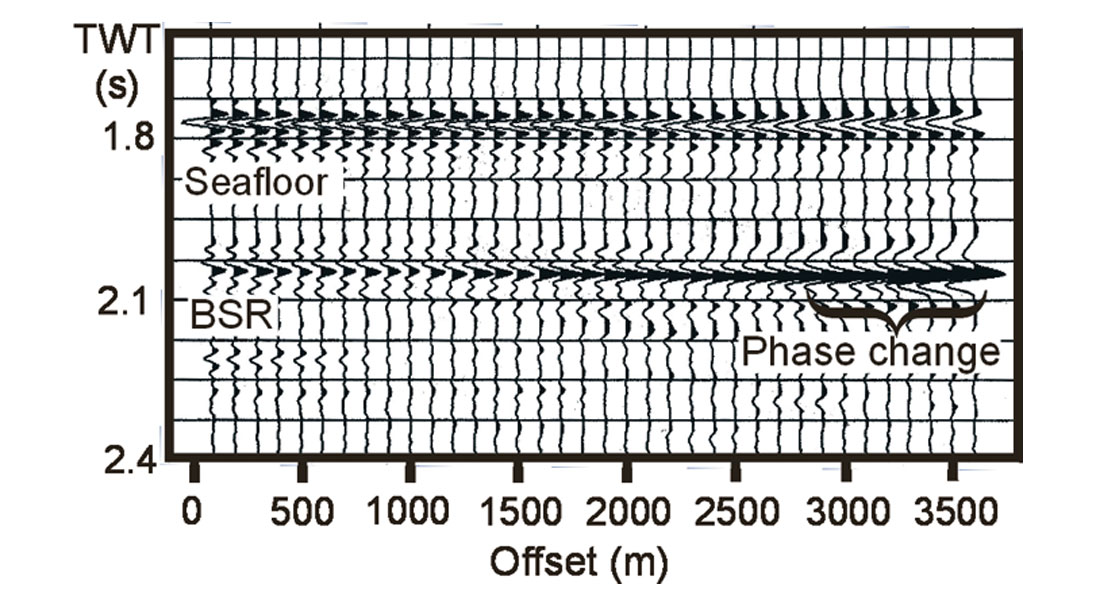
A considerable amount of work has gone into understanding why gas hydrate occurs in environments such as off Vancouver Island. As noted above, it is believed that upward advective fluid expulsion carrying methane is required for high concentrations of natural gas hydrate. A general model for the upward migration of biogenic gas and hydrate formation on subduction zone accretionary prisms such as off Vancouver Island is shown in Figure 17.
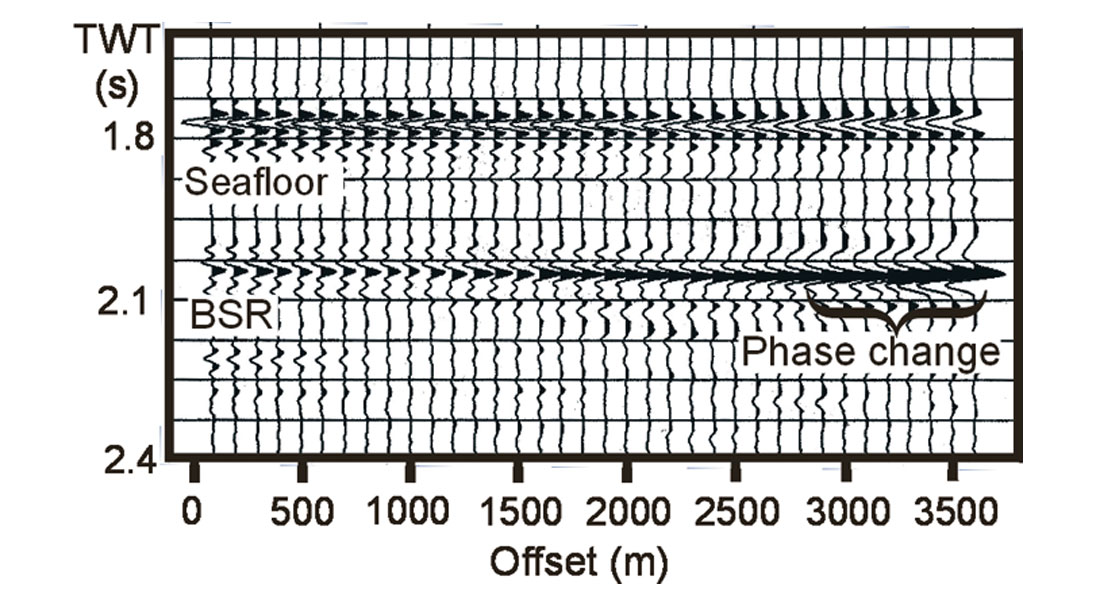


How can we recover natural gas hydrate?
We do not yet know how to recover gas from natural hydrate. We are not aware of a really practical proposal for recovering methane from natural hydrate. We do know that there are formidable technical difficulties:
- Although the total gas amounts are huge, most natural hydrate represents a quite low energy density;
- substantial latent heat must be provided for dissociation;
- the sediments are often fine grained, unconsolidated, and low permeability silts.
There are four main possibilities, (1) add heat and raise the temperature to above that for hydrate dissociation, (2) depressurize the section by pumping, especially within the free gas below the BSR. The hydrate may then dissociate downward into the low pressure gas layer. However, the dissociation latent heat still must be provided, (3) add antifreeze such as methanol; it may be possible to recover the methanol with the gas for re-use, (4) replace the methane in the hydrate with CO2. An intriguing possibility is to inject the unwanted greenhouse gas CO2 into natural methane hydrate deposits where it forms CO2 hydrate in exchange for methane gas which, in turn, is recovered. CO2 hydrate appears to be more energetically favourable than methane hydrate so such a replacement should occur. This an attractive way to get rid of troublesome CO2 and recover valuable methane.
Although there are no clear answers today, it is worth remembering that many years were required to develop the technology for economic recovery of many other resources; tar sands are an example. Sometimes the answers come very quickly, sometimes only after many years. Gas hydrate is a very large potential resource, it just needs some very bright people with new ideas to find the solutions.











Join the Conversation
Interested in starting, or contributing to a conversation about an article or issue of the RECORDER? Join our CSEG LinkedIn Group.
Share This Article